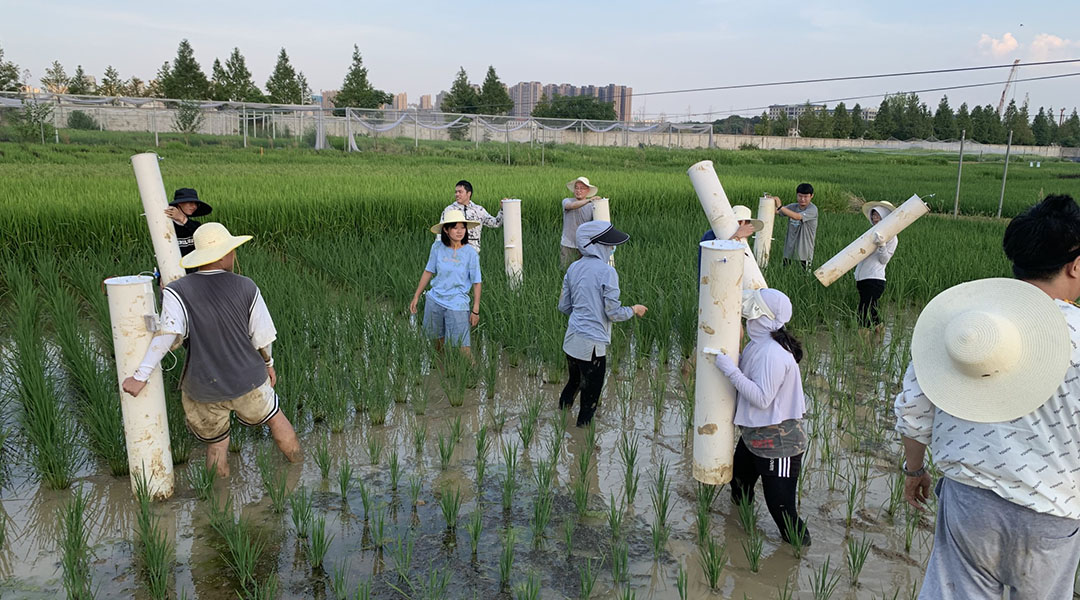A group of scientists have bred a new variety of rice that could help combat rising methane levels around the world.
“Methane has a very strong impact. It’s around 20 times stronger than carbon dioxide,” explained Anna Schnürer, a microbiologist at the Swedish University of Agricultural Sciences and one of the contributing scientists. “Rice field cultivation corresponds to approximately 13% of the methane that humans are releasing into the atmosphere. So, it’s having a significant effect on the climate.”
Rice emits a lot more methane than other cereal crops, such as wheat or barley, as it is grown in flooded fields, which creates an ideal environment for methane-producing microbes to flourish.
“Methane is produced by a group of organisms that are sensitive to oxygen. They thrive under conditions where you have very small amounts of oxygen present,” said Schnürer. “When you put the plant in the water, you decrease the possibility for oxygen to enter the soil.” Schnürer and her colleagues therefore sought to alter the chemistry of the soil by changing the rice plants to limit the amount of methanogenic bacteria that would grow.
After three years of cultivation trials, they developed a new rice variety that reduced methane emissions by up to 70% while also achieving a good crop yield.
Compared to current average global rice yields, which in 2024 was 4.71 tons/hectare, the new low-methane rice achieved 8.96 tons/hectare. Although higher yields can be achieved, for example, 10–12 tons/hectare in exceptional circumstances, anything above 6.0 tons/hectare is normally considered a high-yield variety.
“This study shows that you can have low methane and still have a rice with high yields,” said Schnürer, in a press statement. “And you can do it using traditional breeding methods, without GMO, if you know what you’re looking for.”
A multi-step development process
Low methane rice is not a new concept, but the combination of high yield and low methane is more unusual—and exciting.
To create the low-methane rice, Schnürer, co-senior investigator Chuanxin Sun, also at the Swedish University of Agricultural Sciences, and colleagues in Sweden and China first compared chemical emissions from the roots of two types of rice plants: a genetically modified, high starch, low-methane emitting variety called SUSIBA2, and a widely grown commercial variety, Nipponbare, which they used as a standard control.
This initial study allowed them to understand the process that results in some rice strains being associated with greater methane emissions than others. More specifically, the roots of the SUSIBA2 variety emitted significantly lower levels of a chemical called fumarate than those of the Nipponbare rice, but higher levels of ethanol.
The investigators realized that fumarate and ethanol released from the rice plant’s roots regulate how much methane the bacteria near the roots can produce. High levels of fumarate support the production of methane, whereas high levels of ethanol suppress it.
Although SUSIBA2 rice produces low levels of methane and has a good yield, it is a genetically modified (GMO) crop and therefore subject to strict regulation in some areas. To get around this, the research team searched for existing non-GMO varieties of rice that have these properties.
“We went through a lot of old varieties that are not used commercially today because they are not high-yield plants. In that group, we found several that produced low methane levels naturally. But they were not interesting because the yields were so low,” explained Schnürer. “We then took those plants and cross-bred them with a high yielding rice variety.”
The progeny of the plant breeding experiment were then grown and monitored for methane emissions across a number of different paddy field sites for three years. The experiments were successful, and the new strain produced 70% less methane on average than the standard Nipponbare rice. It also achieved a higher-than-average yield of almost 9 tons/hectare.
The optimum temperature for rice growing tends to be between 20–35°C, but some varieties can tolerate temperatures between 35–40°C. This is likely to become more important as global temperatures increase, particularly in key rice growing regions like Asia.
The new variety is robust but sensitive to high temperatures above 35°C. “When it gets a little bit warmer, we need still to find other varieties that can manage this temperature,” noted Schnürer.
Solving methane pollution on a large scale
Producing a variety of low methane emitting rice is one thing, but achieving widespread rollout of this variety and persuading people to grow it around the world is another challenge entirely.
“Reducing methane emissions is critical to mitigating climate change, especially since rice farming is one of the largest agricultural sources of methane worldwide,” said Sandra Patricia Loaiza Mera from the International Center for Tropical Agriculture in Columbia who was not involved in the study. “Lowering methane emissions contributes to more sustainable production systems, which benefits not only the environment but also local communities dependent on rice farming.”
Schnürer and her colleagues now want to obtain the necessary regulatory approvals to allow their rice plants to be grown more widely and have set up a company called Green Rice Sweden to help facilitate this.
While Schnürer and colleagues work on developing a rice strain for hotter climates, a solution for rice growers in these regions could be to use oxantel, an inhibitor of fumarase, on the soil. While completing this study, the researchers tested adding a combination of oxantel and ethanol to the soil where Nipponbare rice was growing, and found it reduced methane emissions by around 60% without impacting crop yield.
Oxantel is already approved as a drug to treat intestinal parasitic worms in humans and animals, meaning there is data supporting its safe consumption, although further testing in this context is needed to verify this.
Maintaining the soil microbiome to ensure good plant health is also key. “It’s important that you don’t change anything else in the soil microbiology,” emphasized Schnürer, who added that this treatment “appears not to influence a lot. It’s just reducing the number of methane producers. The general microbiology is very similar.”
Another key hurdle before the team’s new strain of rice can become mainstream is to persuade farmers in different countries to grow it. “Several of the researchers and funders are from China, so we will try to approach the Chinese market first to see if we can get it going there,” said Schnürer. “You need the farmers to say they want to have this rice and ideally the government to say that we should use low methane-producing rice varieties.”
Loaiza Mera agrees and adds that many farmers are cautious about investing in new technologies or practices because they are not familiar with them and are concerned that they may impact their crop yield.
“Despite these challenges, the benefits of adopting these sustainable practices outweigh the risks, especially when combined with policies and support systems to facilitate the transition,” she commented.
“The pace of this impact will depend on how quickly farmers adopt these practices and how effectively government and other stakeholders support their implementation.”
Reference: Schnürer A., Sun C. et al. (2025). Reducing methane emissions by developing low-fumarate high-ethanol eco-friendly rice. Mol. Plant (2025). https://doi.org/10.1016/j.molp.2025.01.008
Feature image credit: Kai Sun

















